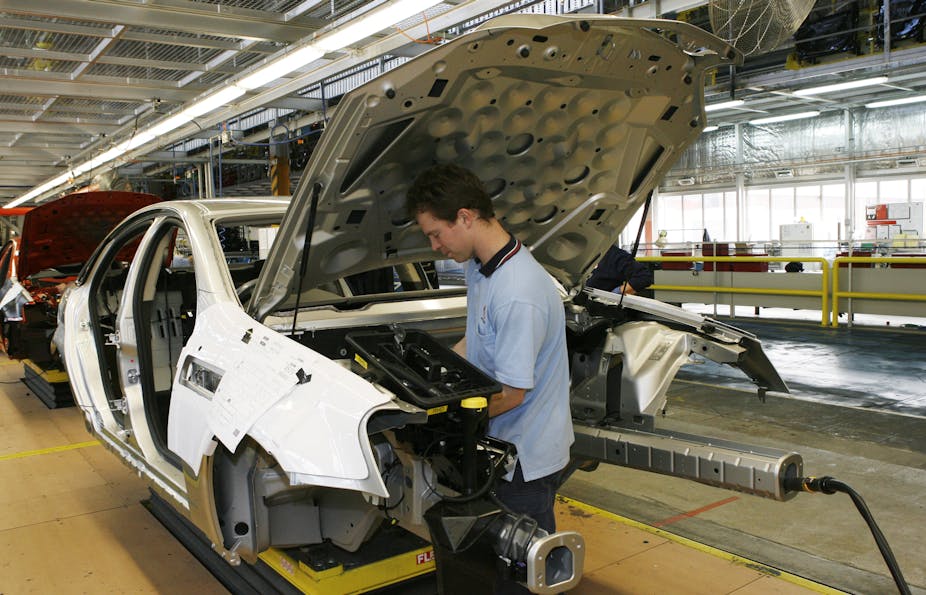The Federal Government will contribute millions of dollars to Australian car manufacturers Holden and Ford in an effort to keep Australia’s automotive sector afloat.
The government will add $34 million to a $103 million rescue package for Ford’s Victorian assembly plant that will see the facility remain open until at least 2016.
The funding, which will be met by a grant from the Victorian Government, comes as Holden is reportedly negotiating with Canberra over co-investment to produce a new Commodore model in 2018.
But should governments continue to bail out an industry that is lagging in Australia and internationally? University of Wollongong Professor of Infrastructure Economics Henry Ergas explains the problems of extending further assistance to the ailing sector.
Do direct bailouts of this variety serve to ensure a sustainable future for the car manufacturing industry?
The experience to date is that it steers it towards further external, tax-payer funded bailouts. We have a long history of providing these bailouts now.
Basically the industry has received about $500 million worth of assistance each year since 2001. That program of direct assistance was meant to run until 2015, but has now been extended to 2020. That will provide a total of about $10 billion worth of assistance to the industry.
All that $10 billion looks likely to achieve is an industry that is habituated to – and its critics would say addicted too – receiving continuing support of that kind.
I don’t think this situation will induce the industry to become sustainable on its own two feet.
What kind of policy alternative would you like to see?
The sensible option would be to phase down the current assistance, and return to the original 2015 end date. We also need to rein in the additional forms of assistance, such as the funding that was announced for Ford on Tuesday.
At the very least, what we need is a comprehensive, rigorous and independent review of the assistance to ensure that it is giving tax payers value for money. At the moment we don’t have any such comprehensive framework to provide assurance this assurance.
In 2008 there was supposed to be a Productivity Commission review of the automotive industry, but the newly elected Rudd Government decided instead to have a review that was undertaken by a hand-picked group chaired by former Victorian Premier Steve Bracks.
While that panel undoubtedly did as good a job as it could, the reality was that it didn’t have the long expertise that the Productivity Commission has in examining assistance programmes – particularly for the automotive industry. It also wasn’t as clearly independent as a Productivity Commission review would be.
Given that what we have now seen, particularly in the course of the last year or so, the proliferation of ad hoc funding to firms, it is high time that we went back to the Productivity Commission and got the thorough review that should have been carried out in 2008.
Is Australia’s automotive industry sustainable in the long term?
This is a question that will ultimately be answered by market forces and competition. The reality of it is – as we saw with the closure of Mitsubishi’s Australian plant in 2008 – that if a firm is not viable, tax payer subsidies are only going to delay the inevitable. They won’t prevent it from occurring.
What we need is to assess firms’ viability by exposing them fully to competitive forces. What do I think the outcome of such a market test would be? I’m quite sceptical about whether there is a long-run future for the assembly of passenger vehicles in Australia.
This is an industry that was born from very high levels of protection and has depended throughout its existence on the continuation of high levels of assistance. None of that makes me hopeful for the long-term prospects of the industry.
What is happening in our economy more generally is that we are shifting from the industries that we inherited from the 1930s and 1940s towards industries that are better matched to and better aligned with our longer-term comparative advantage.
Even within manufacturing there is a very big shift occurring from traditional manufacturing towards industries that supply manufactured inputs to mining and agriculture. We’re not seeing a disappearance of manufacturing. In fact, manufacturing is doing quite well.
But what we’re seeing within manufacturing is a shift from producing the sorts of good that we produced in the era of high protection towards the sorts of goods that are consistent with an economic that is more heavily oriented to our comparative advantage in resources.
That’s why Australian manufacturing has had an investment boom. The key element of that boom is that it is re-tooling manufacturing for those new areas.
What we manufacture and how we manufacture is going to change, and that is an inevitable change and one that we should welcome rather than fight against it by wasting taxpayer dollars.

